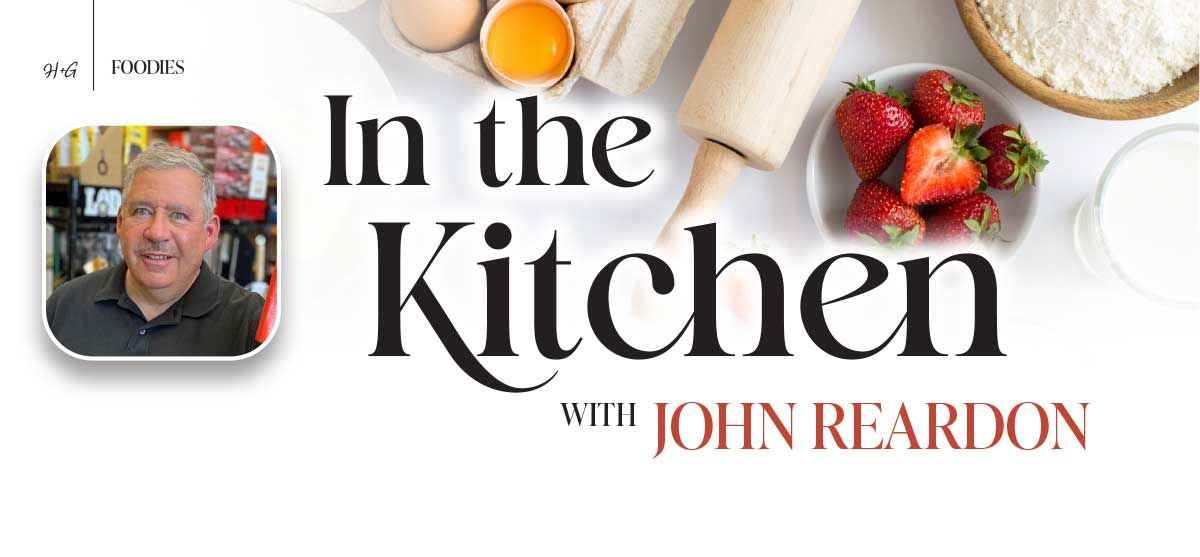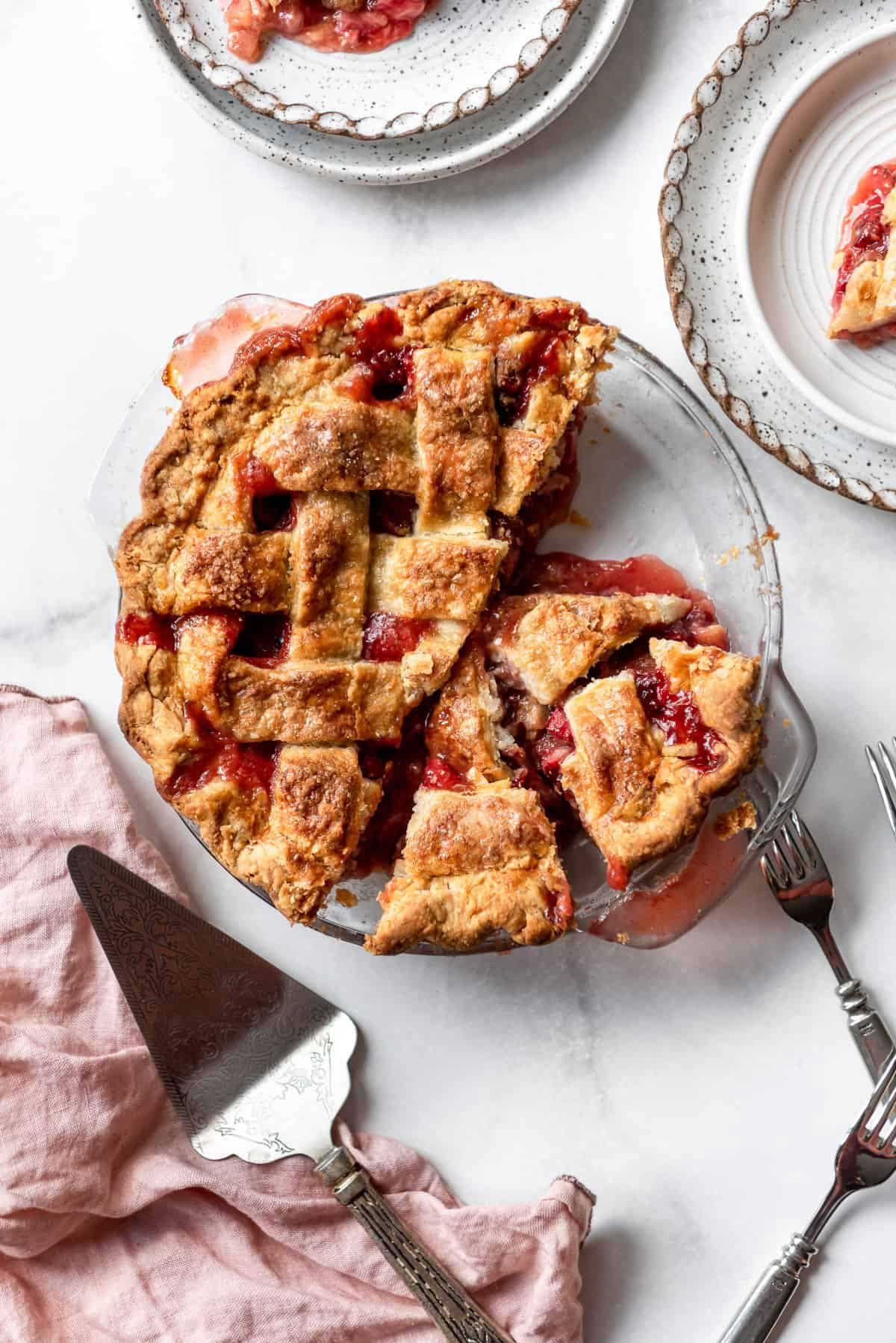
[From the 2025 Spring Magazine]

Food has always been a central part of my life. All of my happy childhood memories center around food, whether gathering, cooking, or eating. I can close my eyes and see my mother kneeling in her vegetable garden smiling wearing her garden-tool patterned gloves. She would gather her vegetables, taking pride in the zucchini, squash, vine tomatoes, and strawberries grown. I loved to watch her garden and would get into the thick of it, eating ripened tomatoes from the vine. She would call out for me to stop as I pulled every ripe strawberry, to drop them from my greedy hands. The only way this request would work was the promise of strawberry-rhubarb pies, one of my favorite pies to this day.
Springtime, with its blooming flowers, warmer weather, and longer days, is often associated with new beginnings and fresh starts. It can be a time of setting new intentions. Perhaps start that vegetable garden you have been talking about, or purging your house of items you no longer use. Cooking is a creative form of labor, whether you are preparing a rigorous recipe or a quick snack. Consumers are continuing to focus on quality items to cook with, and prioritizing fresh, minimally processed ingredients like locally sourced produce, whole grains, high-quality cuts of meat, fresh herbs and spices, and responsibly sourced seafood, avoiding excessive additives, preservatives, and artificial flavors; essentially, and opting for ingredients that retain their natural flavor and nutritional value. Along with quality products, comes the shift towards using the best items to prepare our food.
Cooking has long been the cornerstone of many cultures — and it’s not hard to see why: there is something so satisfying about transforming raw ingredients into a delicious meal. The process can be seen as both an art and a science. Of course, in order to truly master the craft of cooking, you need the right equipment. Whether you’re a home cook or a professional chef, having the best cooking equipment within reach will make all the difference when it comes to giving your recipes that ‘wow-factor.’


If the dining table is the heart of every home, then kitchens are the vessels that keep it running. By putting more thought into how to choose your cookware and cooking utensils, you are not just making your kitchen reliable—you are piecing it together to last a long time. Many of our customers are remodeling kitchens or reevaluating the current cookware and knives they use while looking at revamping and moving towards new quality items. Kitchens are complex wonderlands. These are places where the best concoctions and recipes were made and discovered. But before all that sumptuous food gets in your stomach, processes come along with cooking—which requires the best kitchen utensils.
Cooking equipment can make meal preparation easier by providing the right tools needed to prepare a variety of meals. From pots and pans to blenders and whisks, these tools can greatly increase the variety and scope of recipes you can create. For instance, oven mitts and pot holders help protect hands against hot surfaces in the kitchen. Skillets and pans provide a stable surface for your food while being heated on the stovetop. They are made of heavy gauge materials like stainless steel and cast iron to ensure even heat distribution throughout your cookware. Thermometers can help ensure that foods have reached a safe internal temperature and make food safety fool-proof.
Digital thermometers provide accurate readings on the spot to guarantee that your meals are cooked properly every time. A timer helps in keeping track of how long foods have been in the oven or on the stovetop to avoid burning. Choosing a great knife for cooking is crucial because a high-quality blade is significantly sharper, more precise, and easier to control, leading to safer and more efficient food preparation, allowing for clean cuts, minimizing damage to ingredients, and reducing hand fatigue compared to a dull or poorly made knife; essentially, a good knife enhances your cooking experience and can significantly improve the quality of your dishes. This is a small list of tools that can make a difference in your kitchen.
Springtime is a good time for cleaning and decluttering your kitchen. Additionally, outdoor cooking becomes more popular as the weather gets warmer, so restocking your kitchen with grilling tools and supplies can be a good idea. This Spring, stop into Compliments to the Chef, your Neighborhood Kitchen and Cutlery store located at 33 Railroad Place. Pick up the tools you need to help you make a difference in your meal preparation.



Ingredients
- 1 double-crust pie crust
- 2 1/2 cups rhubarb chopped into 1/2-inch pieces
- 2 1/2 cups strawberries washed, hulled and cut into pieces about the same size as the chopped rhubarb
- 1 cup granulated sugar
- 3 Tablespoons minute tapioca
- 1 Tablespoon all-purpose flour
- 1/2 teaspoon lemon zest
- 1/2 teaspoon lemon juice
- 1/2 teaspoon ground cinnamon
- 1 teaspoon vanilla extract
- 3 Tablespoons salted butter
- 1 beaten egg
- 1 teaspoon water
- Extra sugar for sprinkling on top of crust
Instructions
1. Using a double crust (recipe or purchased), roll out one half of the crust and cover the bottom of a pie dish, while reserving the other half of the dough for the top crust.
2. Mix the rhubarb, strawberries, sugar, tapioca, flour, lemon zest and juice, cinnamon, and vanilla together in a large bowl and pour out into prepared crust.
3. Slice the butter into small chunks and place them around the top of the strawberry rhubarb filling.
4. Roll out the remaining half of the pie crust and gently place it over the filling, either as a solid crust with slits cut into it for ventilation or by cutting into strips and laying them out in a lattice pattern. Crimp to seal edges.
5. Make an egg wash by beating an egg with 1 teaspoon of water in a small bowl, then brush it over the top of the pie with a pastry brush and sprinkle the top of the pie with a teaspoon or two of sugar.
6. Loosely cover the edges of the pie with foil and bake at 425 degrees F for 15 minutes. Decrease temperature to 375 degrees F and bake for an additional 45 to 50 minutes, or until the filling is bubbling and the crust is golden brown.
7. Let the pie cool for at least 2 hours before cutting and serving.
Recipe courtesy of House of Nash Eats at houseofnasheats.com